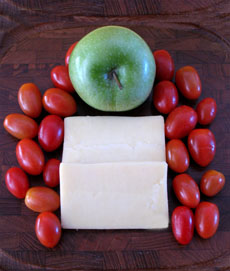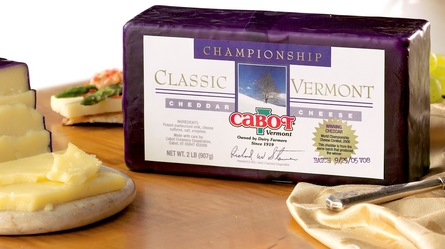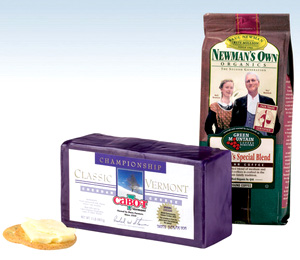

Cabot Championship Cheddar, surrounded by a garland of teardrop tomatoes. Photo by Andy Lin.
|
KAREN HOCHMAN is Editorial Director of THE NIBBLE™.
|
December 2006
|
 |
Cabot Creamery Championship Cheddar
The “Best Cheddar In The World”
CAPSULE REPORT: Cabot Creamery’s cheddars have won so many awards that in 1999, the company became the first U.S. cheese producer to export cheddar to England, the birthplace of cheddar (and a country where people know a thing or two about quality). While we eschew absolute titles of “best [whatever] in the world,” we greatly enjoyed our block of Championship Cheddar. Now, we must wait like everyone else for next year’s batch of this sold-out, limited-quantity cheese. But if you’re willing to buy it in a gift set with coffee, or track it down at specialty cheese shops, it still is obtainable.
Those who keep abreast of cheese competitions know that Cabot Creamery has been earning its share of awards. This year, the Vermont cooperative’s Sharp Cheddar won “World’s Best Cheddar” at the 2006 World Championship Cheese Contest held in Madison, Wisconsin. From the same batch of curds that created the cheddar submitted for the competition, the company produced two-pound blocks, aged to perfection like their award-winning sibling.
That cheddar, shown in the photo below, was on our “Best Holiday Gifts” list. Aged for more than two years, it is an elegant, mouth-watering cheddar. The aroma is fresh and savory with a hint of nuttiness. On the palate it is rich and silky, buttery, not tangy. It is a cheese you could eat all night...and one you would beg to fondue, if only you could get another few blocks.
Alas, before our December issue could appear, the single blocks sold out. The company recommends their Vintage Choice Cheddar, also a purple-wax selection. And, the Championship Cheddar still is available in a gift set that includes a bag of Newman’s Own Special Blend Organic Coffee.
| Blocks of purple-waxed Championship Cheddar were taken from the same batch of curds that produced the World Championship. |
 |
Cabot Creamery Cooperative is a dairy cooperative owned by the farmers whose milk makes its products. It has been in continuous operation in Vermont since 1919. In 1992, Agri-Mark, a Massachusetts dairy co-op, took control of the business and has made it the Northeast’s premier dairy cooperative, growing the business without letting quality slip. In fact, the products keep racking up awards, at both the biennial World Cheese Championships and the annual American Cheese Society competition. The cheeses are available to customers nationwide via the online store.
Cabot ages its cheese naturally, instead of using enzymes that speed up the process, which is how much commercial cheese is made*. This means that Cabot cheddars age for a year or so before being released to market, and is how they achieve rich, full-bodied flavor. It is also why the Cabot varieties that are sold in the supermarket taste different from, e.g., Kraft® Cracker Barrel® cheddars. Enzymes can create an extra-sharp cheddar in 5 months instead of 22.
*Cabot uses only a modicum of enzymes, which are essentia to make the cheese.
Cheddar Facts
Cheddar originated in the Somerset region of England. A semi-hard cheese, it is always made of cow’s milk. You can read more of the history of cheddar in a separate article devoted to the topic.
- Color. The normal color of cheddar is white color to pale yellow. Some cheddars have a vegetable color added to give the cheese a yellow-orange color. Originally this was done to indicate area of origin. Today, it is a matter of preference.
- Sharpness. A cheese’s sharpness is determined by how long it has been aged. With naturally aging, a mild cheddar is generally aged for 2 to 3 months, whereas an extra sharp might be aged a year or more. The finest cheddars are aged for at least 2 years to achieve that sharp, crumbly texture.
- Wax. The goal of cheddar packaging is to keep and eliminate the chance of molding. There are three typical packaging methods for cheddar. The traditional method is wax: because cheddar ages for a long period of time, the cheeses are traditionally waxed to keep air out and eliminate the chance of mold growth. The color of the wax has no quality designation or other meaning within the industry, but individual companies may designate colors for their own marketing purposes. The two more modern packaging methods use plastic films and either a vacuum packing or "gas flushing" technique to remove the air before sealing.
- Sweating. It is common for a small amount of moisture to develop inside cheese packaging. The cheeses will give up moisture as they age in a process known as syneresis: extra sharp cheddars will sweat more, e.g. This is a natural consequence of the aging process that allows the cheese to reach the next stage of maturity.
- The Lactose Myth. Aged cheeses such as cheddar contain zero grams of lactose. Contrary to popular belief, unlike many dairy products, cheese in general is extremely low in lactose. Most cheeses have 1 gram or less per serving. For those who are extremely sensitive, goat’s milk and sheep’s milk cheeses have more digestible proteins than cow’s milk cheeses.
Serving Suggestions
Cheese is always at its best when served at room temperature. Allow 30 minutes after removing the cheese from the refrigerator prior to serving for the full full flavor and consistency to show themselves.
- Wine Pairing. Pairing wine and cheese is ultimately a matter of personal taste. Extra sharp cheddars, which have an intense flavor, match well with a full-flavored pinot noir or cabernet sauvignon.
- Wrapping The Leftovers. Wipe off any excessive moisture, Unlike many cheeses that need to breathe, cheddar can be wrapped in plastic wrap. Use fresh wrap each time you return the cheese to the refrigerator.
- Melting. Mild cheddars will melt easily and consistently, however, low-fat cheddars and sharper cheddars will melt well if first shredded or cut into strips and warmed over low heat.
In addition to being part of a cheese plate, a good cheddar makes a wonderful cheeseburger, grilled cheese sandwich, ham and cheese sandwich etc. For a country that is used to throwing plastic-wrapped singles on top of everything, the taste of using a real cheese on comfort-food favorites can be an epiphany. Try it and see.
If you’re in Vermont, stop by to visit the Creamery and taste the different cheddars. Cabot is open daily June through October, and Monday through Saturday November through May. But telephone 1.800.837.4261 to confirm that cheese is being made when you plan to visit.
CABOT CREAMERY
Cheddar Cheese
Gluten Free
- 2-Pound Championship
Cheddar (SOLD OUT)
$18.95
- 2-Pound Vintage Choice
Cheddar
$18.95
- Championship Gift
2-Pound Cheddar and
Newman’s Own Coffee
(shown at right)
$28.95
Purchase online at
CabotCreamery.com
|

A gift set of two of Vermont’s most award-winning gourmet foods, packaged in a farm-scene gift box: the 2-lb block of Cabot Championship Cheddar and 10-ounce bag of Newman’s Own Special Blend coffee from award-winning Green Mountain Coffee Roasters. |
Prices and flavor availability are verified at publication but are subject to change.

|






